1 Project Background
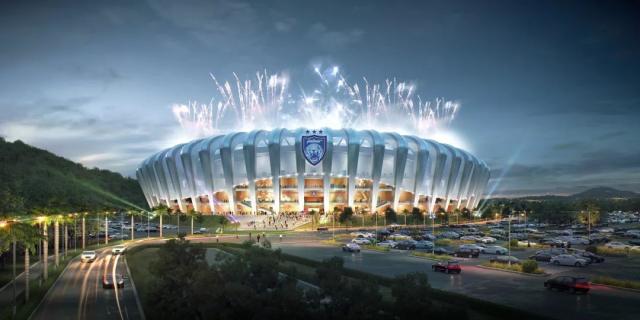
Johor Darul Takzim Football Club (Johor DT or JDT) is a football club in the state of Johor, Malaysia, and was awarded the Best Club by the AFC in 2015.In 2016, Johor DT kicked off a programme to build a new stadium, the Sultan Ibrahim Stadium in Lah Keng, with the goal of creating a new stadium that meets the standards of the Johor DT Championship Home Stadium. The goal was to build a new stadium in line with Johor DT's championship home, a new stadium with a focus on league matches and international matches that meets FIFA standards.
The JDT club had engaged local Singaporean and Malaysian design firms to develop a conceptual plan for the project, but this was not approved by the club's management and we were commissioned to develop a conceptual plan with a very short lead time. Prior to this, we had no in-depth knowledge of Johor Bahru and the JDT team; through the club's introduction, we learnt about the importance of local players and government officials to the team and the passionate fan culture in the area, and the team's plan to build a new stadium received a great deal of appreciation and support from the fans once it was launched.
2 Design Concept
The design concept of the conceptual scheme starts from the local football culture - FIFA says: football venue is the place where people all over the world celebrate football events. Stadium is a place to share enthusiasm, energy and prosperity.
We came up with the idea of a 'Football Fest' - a top-class stadium for championship teams and an 'event' for Johor fans to share enthusiasm and energy.

Designed to represent the state of Johor and promote local culture as the starting point, we are committed to creating a home stadium that is the soul of the team and the temple of the fans; combined with Malaysia's unique tropical rainforest culture, the building form is conceived from the soft curves of the banana leaf, taking into account the structural and morphological requirements, and responding to local climatic characteristics, through the veins of the leaf type skin The light is controlled through the skin texture of the leaf veins, and the membrane structure is used to diffusely reflect the sunlight, so that the sunlight entering the venue is soft and even.
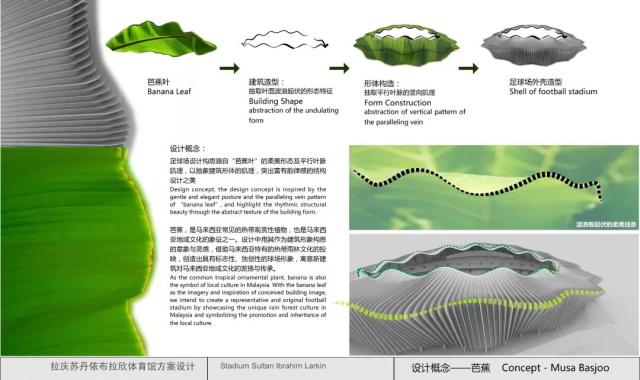
The conceptual design emphasises the passion and freedom of the architectural form, which is highly appreciated by the club's managers; however, after the conceptual design was finalised, the club put forward strict cost control requirements.
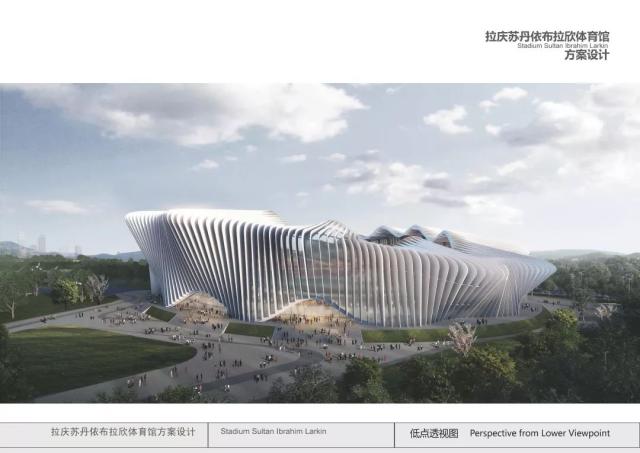
3 Structural and Modelling Integration Design
3.1 Morphological optimisation
In the deepening design stage, the architectural design combined with the structure, curtain wall scheme and overall cost control to optimise the building form.
Optimisation process 1: reduce the density of louvres. Although the density of the louvre is reduced, the cost of the louvre as a purely decorative solution is still difficult to control.
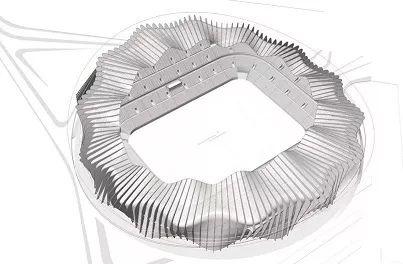
Optimisation process 2: Unification of structural form and shape. As a structural component of the roof, louvres are designed to play a structural role rather than a decorative element.
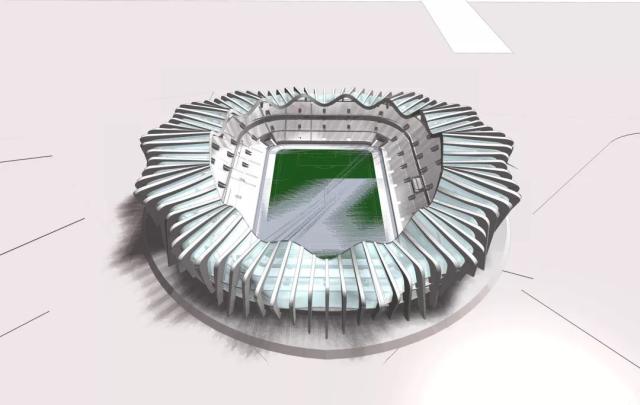
Optimisation process 3: Reduce the roof overhang span. Control the span of the roof so that more sunlight can shine into the building.
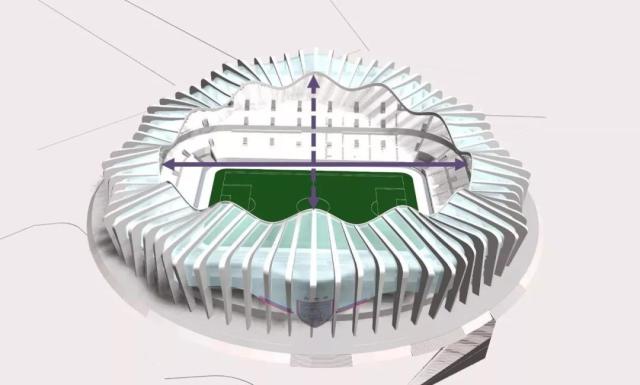
Optimisation process 4: Integration of building forms. Eliminate the floor-to-ceiling wave form and flatten the roof.
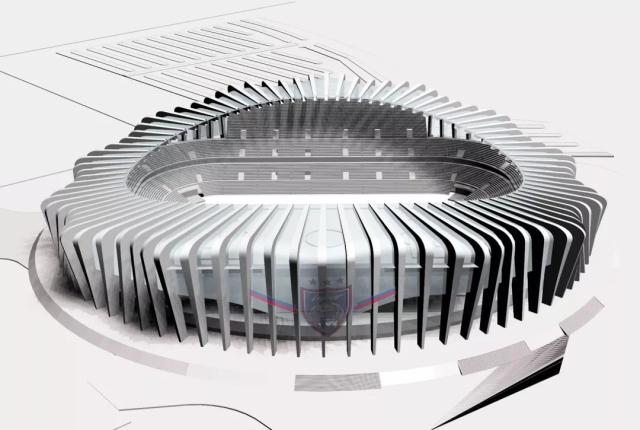
Optimisation process 5: Unification of structure and form. The form of the building was regularised and the structure was designed as a 'banana leaf'.
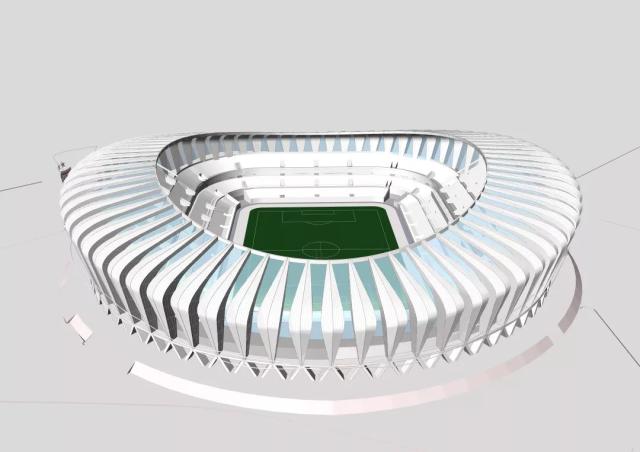
The optimisation process was based on the principle of minimising decorative design content and integrating architectural form and structural technology as much as possible, resulting in a geometrically regular building with rationally rounded components.
Although there is a certain difference in form from the initial conceptual plan, the architects had to make a reasonable balance between emotional conception and rational technology and cost constraints. Although the optimised building form is less free-spirited, it highlights the simple geometrical aesthetics, and the combination of construction technology and detailing is more delicate.
3.2 Structural System
The stadium adopts reinforced concrete frame structure - space steel truss structure system, wrapping aluminium panel curtain wall on the basis of structural truss, and adopting single-layer tensioned membrane structure between trusses.
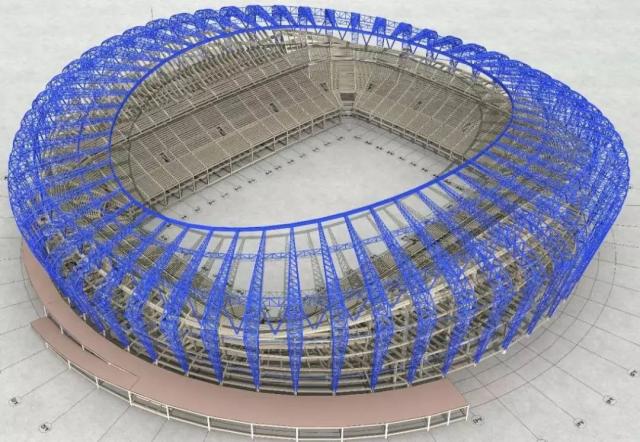

The aluminium panels of structural trusses are set up with long vertical open seams on the front side, and the horizontal line seams are treated with hidden seams, highlighting the vertical lines of the building façade, and the panels are compartmentalised in long trapezoidal shapes. Considering that there are more aluminium panel curtain walls with inwardly inclined forms in the architectural shape, the cleaning problem of the panels still needs to be paid attention to. Through the comparison of material samples, comprehensive cost factors finally selected photocatalyst spraying technology, that is, in the aluminium surface spraying photocatalyst protective layer to form a self-cleaning layer, in the natural situation of rain and wind environment, can play a self-cleaning and no dust to leave traces of the effect.
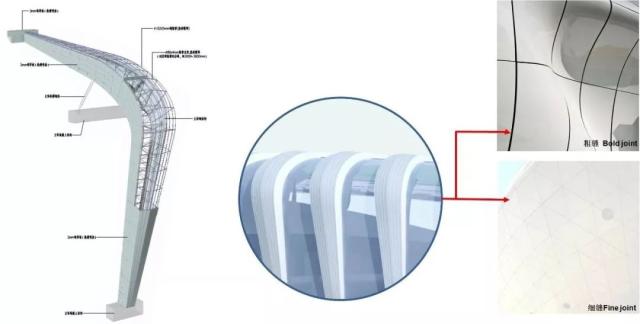
3.3 Enclosure System
Aluminium grille ceiling design: the bottom of the space steel truss is combined with the lighting fixtures of the auditorium to arrange the grille ceiling, the size and thickness of the grille are determined according to the technical requirements of the curtain wall design, and at the same time, the position is reserved for the lighting fixtures.
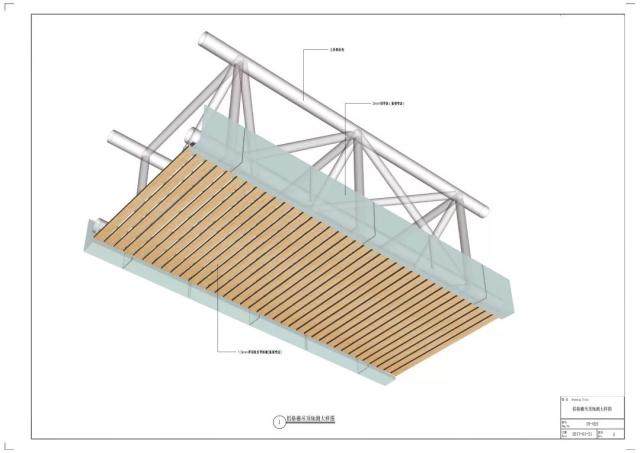
Membrane roof design: the roof structure between the trusses using translucent, high transmittance PTFE single-ply tensile system membrane, light for uniform scattered light, light transmission opaque, and strive to membrane surface continuous flat, rounded corners of the smooth continuity, PTFE membrane surface has anti-adhesion, stain resistance, easy to clean the characteristics of the rainwater can be cleaned.
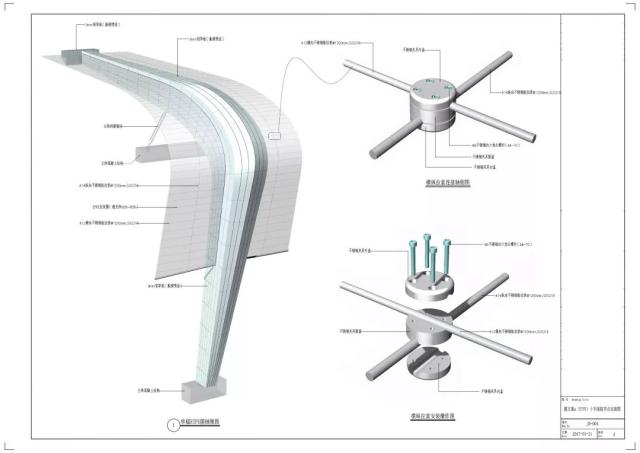
Roof drainage system design: Due to the requirements of the building form, it is difficult to set up external gutter on the roof, and the drainage of the roof becomes a problem. Combined with the structure of the curtain wall, we consider setting up lateral drains, and the rainwater from the membrane surface is discharged to the roof drain hidden in the metal curtain wall through one side, and then leads to the ground through the intercepting gutter at the corner of the roof and the façade.
Through water flow simulation, due to the difference in slope and flow rate, more rainwater from the membrane surface will be discharged to the outside to form a rain curtain, and the lateral gutter scheme can only drain away 38% of the rainwater from the roof, which is much different from the initial expected amount. In order to minimise the impact of drainage on the building façade, we deepened the design with the curtain wall unit, added a cut-off gutter at the critical position of the slope, and hid the gutter by dividing the membrane surface into high and low segments to form a difference in height, which ensured the visual continuity of the membrane surface.
4 Climate adaptation design
The location of the stadium belongs to the tropical climate, with rainy and sultry climate characteristics, which brings a great test to the design of the stadium. In order to control the cost, the club required a reduction in the proportion of the actual shade of the canopy. In order to prevent the temperature of the seating area from being too high during the match, the CFD analysis of sunshine and airflow was carried out through computer simulation, and measures such as lowering the height of the canopy in the direction of high wind frequency, increasing the opening area of the canopy, and reserving sufficient ventilation openings in the windward direction of the grandstand were finally taken to ensure the comfort of the spectator area of the stadium's grandstand.
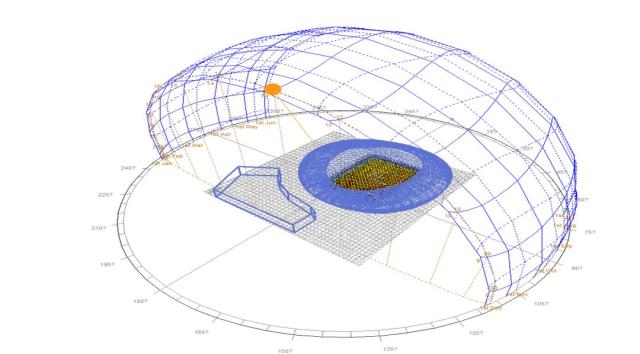
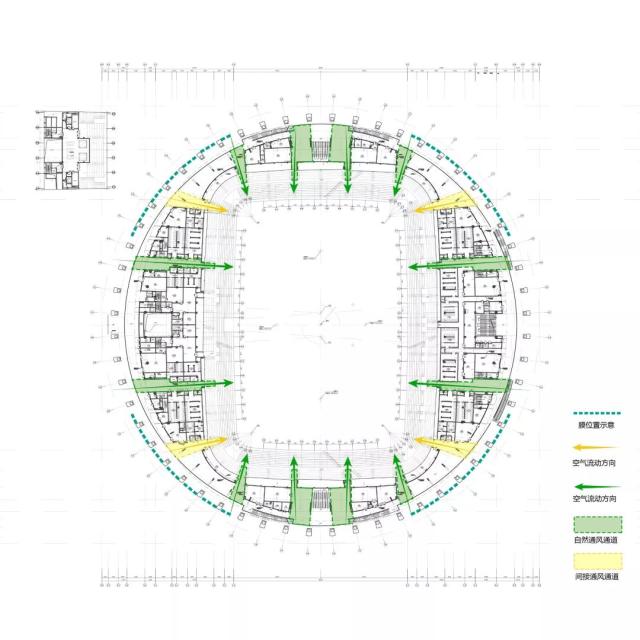
In addition, due to the influence of the local climate, rainfall often occurs during matches. The grass drainage efficiency of the existing pitch used by the Club is very low, and once it rains, it often turns into a pool of stagnant water, which seriously affects the quality of matches. Therefore, the club set a very high standard for the new pitch's turf, not only to ensure drainage efficiency, but also to ensure that the grass has the right lighting and ventilation conditions. Sample tests were conducted on site on a variety of turf configurations to develop the most suitable turf programme for the local area.

The turf consultant also made detailed comparisons of a variety of grass samples and finally selected Zoysia Zeon, an imported Japanese grass that is best suited to the Malaysian weather. After the completion of the turf field, the turf field will reach the FIFA 2-star certification, which will meet the requirements of the FIFA International Class A matches.
5 Standardised Design
The design of the stadium's internal facilities and operation flow line is in accordance with the FIFA 2011 version of the "Technical Recommendations and Specifications for Football Stadiums". However, the FIFA standards are more oriented to the general tournament specifications, and are not comprehensively applicable to the needs and operation of club matches. In the design process, in addition to complying with some of the mandatory requirements of the FIFA standards, we also adjusted the stadium in accordance with the club's mode of operation, and the club also made reference to some new stadiums in foreign countries (mainly the new Allianz Stadium of Juventus) to put forward some new requirements on the stadium's internal facilities (especially the part of the changing rooms).
In terms of grandstand design and event flow design, FIFA's technical standards have strict requirements on seat sightlines, including sight distance, overlooking angle, and sight line obstruction.

In view of the small size of the seats required by the club, the arrangement of the grandstand seats is controlled according to the FIFA standard optimal sight distance of 90m, and the stadium seats adopt a compact layout with a nearly circular outline, more east-west and less north-south, and the optimal sight distance of the seats reaches 90%. The grandstand adopts a curvilinear shape to enclose the seats, forming a sense of gathering the atmosphere of the home stadium.

In addition, taking into account the growing number of JDT fans, the seating arrangement takes into account the different sizes of season ticket fans, home team fans, away team fans, and fanatic fans. Clear safety segregation is provided between home and away fans, between fanatics and ordinary fans, and between the seating area and the internal operational flow.
6 Refined Design for Team Operations
Unlike stadiums in China, the JDT Stadium is orientated towards the club's tournament operations, with an emphasis on improving the quality of the club's home stadiums and increasing operational revenue as the intrinsic motivation for the renewal of the stadium. In addition to the increase in seating capacity, the new stadium features retail businesses that will allow the tournament operations to increase matchday revenues, VVIP boxes that provide dining and audio-visual facilities, a fan club for daily operations, a VIP members' club, and a themed restaurant for the club, among other operational facilities.
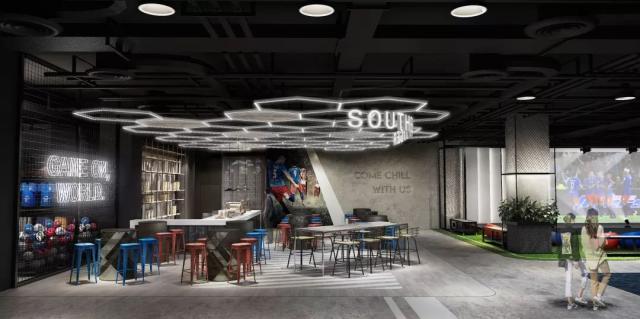
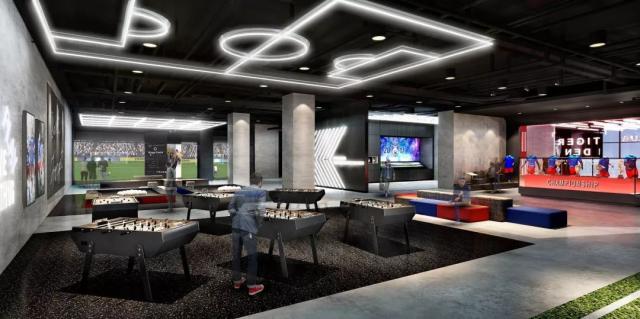

The interior design of the stadium is also based on the culture and history of the club, such as the colour scheme of the seating in the team's themed VP gradient;
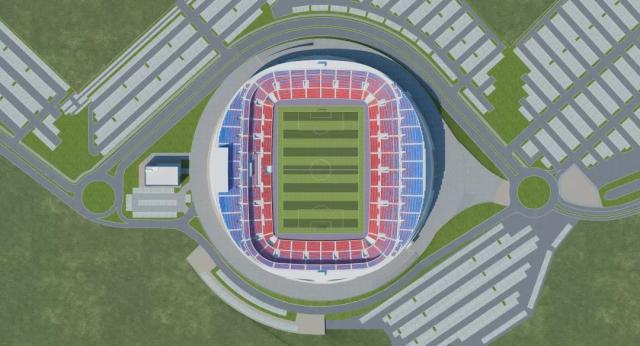
The atmosphere of the home team's sense of belonging and glory is created from the athletes' entrance to the locker room, from the warm-up area to the players' entrance channel, interview area, press room, and from the parking area to the stadium, spectators' lounge, and then to the grandstand seats.
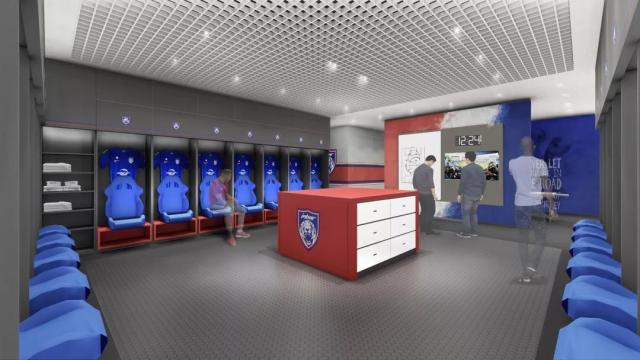
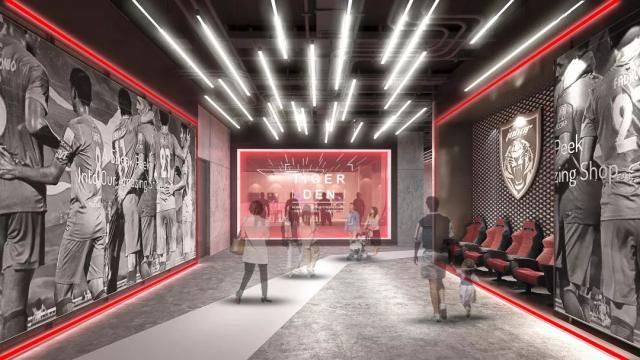
7 Conclusions
The construction of the stadium is nearing completion and is expected to be completed by the end of 2019, and the design cycle of the whole project is shorter than the conventional design. This is not the first overseas project for the South China Centre of BJI, but it is the first one where the planning approval and construction approval were carried out in full accordance with overseas local conditions. The local design consultant responsible for our design was also quite inexperienced in this type of large-scale public building (there were fewer projects of a similar scale in the region), which made it difficult for them to play a good role in assisting the design.
During the design process, BRC South China Centre had to feel and re-understand the local construction planning requirements, fire protection design and other provisions, especially because the local architectural design development level is relatively lagging behind, and there is a lack of local norms or standard basis for a lot of design data, and more often than not, it can only be used in conjunction with the local situation by referring to the domestic norms as appropriate, which is also a common problem encountered in the process of participating in the design of overseas projects. However, with the joint efforts of the design team, the construction of the stadium is proceeding in an orderly manner, and we are very much looking forward to the birth of such an overseas project.
Client: JohorDarulTa'zimFC (JDT) Johor DT Football Club, Malaysia, BGM Malaysia Regional Design and Consultancy Management Department (on behalf of the construction party)
Location: Johor Bahru, Malaysia
Architectural Design: Beijing Architectural Institute South China Design Centre
Interior Finishing: AEDAS INTERIOR Singapore
Landscape Architecture: CPG CONSULTANTS PTE LTD
LDI Reporting & Fire Protection Consultant: LEMBAGA ARKITEK MALAYSIA (SAADON)
LDI Electromechanical Systems Consultant: MECHANICAL AND ELECTRICAL CONSULTING ENGINEERS
Sports Craft Design Consultant: BEIJING CHINESE BODY ARCHITECTURAL ENGINEERING DESIGN CO.
Project Leader: Jie Huang, Taiyun Huang
Design Team: Li Minxi, Liu Jiawang, Li Nano, Tang Yingyin, Zhou Lu, Lv Congjiang, Yang Ying, Du Yuanzeng, Li Yuanbo, Liu Daxin, Zhang Yulin, Zheng Zhuhua, Qiu Xingyu, Feng Shichen, Luo Shanghua, Ye Jun, Hu Xueli, Zhang Shen, Liu Xu
Design Time: 2016.03~2017.03
Project Status: Under Construction
Note: This article was originally published in the third series of BIAD Creation




 Login
Login Register
Register
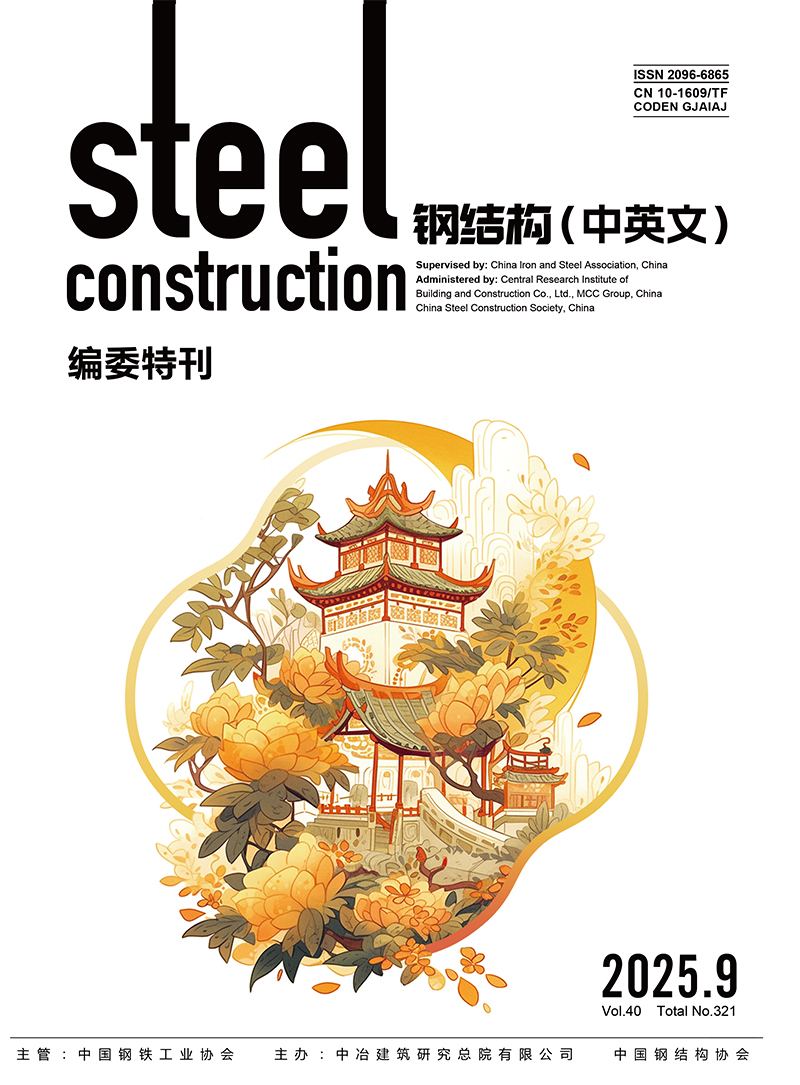
 Steel Construction Published the List of Highly Influential Articles of 2020
Steel Construction Published the List of Highly Influential Articles of 2020





